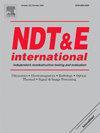Non-contact ultrasonic stress measurement using lamb waves
IF 4.1
2区 材料科学
Q1 MATERIALS SCIENCE, CHARACTERIZATION & TESTING
引用次数: 0
Abstract
Stress measurement is essential in many applications such as aerospace or construction, and ultrasonic stress measurement systems are removable and non-destructive. Using air-coupled ultrasound has the advantage of being non-contact. In other works, an air-coupled ultrasonic phased array is used to adjust the coupling angle and then measure the stress using the conventional transit-time method. In this work, we investigate using the coupling angle of air-coupled Lamb waves directly to measure normal stress in the specimen. The coupling angle is dependent on the phase velocity, which, in turn, changes with the stress. We model that effect using numerical simulations with the semi-analytical finite element method. Ultrasonic measurements are conducted on foam-filled sandwich panels with two 0.5 steel face sheets during full-scale bending tests according to EN 14509:2013. The ultrasonic stress measurement setup consists of an air-coupled phased array for transmission, a MEMS-microphone array for reception, and a laser Doppler vibrometer for reference. We measure the stress via the coupling angle using either the transmit or the receive phased array, and for reference, we measure the stress via the transit-time using the group velocity. The measurement method with the coupling angle method works, both with the transmit or the receive array, with a repeatability of 5.3 and 4.1, respectively, in the range of 0 to 150. The transit-time measurement performs better than the coupling angle method with a repeatability of 2.1 since time measurement is more accurate. However, the coupling angle methods measures phase velocity instead of group velocity. Therefore, both methods can be advantageously combined.
利用lamb波进行非接触式超声应力测量
应力测量在航空航天或建筑等许多应用中是必不可少的,超声波应力测量系统是可拆卸的和非破坏性的。使用空气耦合超声具有非接触的优点。在其他工作中,采用空气耦合超声相控阵调整耦合角度,然后使用传统的透射时间法测量应力。在这项工作中,我们研究了使用空气耦合兰姆波的耦合角直接测量试样中的法向应力。耦合角取决于相速度,而相速度又随应力的变化而变化。我们用半解析有限元法对这种效应进行数值模拟。根据EN 14509:2013,在全尺寸弯曲测试中,对带有两块0.5mm钢板的泡沫填充夹层板进行超声波测量。超声波应力测量装置由用于传输的空气耦合相控阵、用于接收的mems麦克风阵列和用于参考的激光多普勒振动计组成。我们使用发射或接收相控阵通过耦合角测量应力,作为参考,我们使用群速度通过传递时间测量应力。耦合角法测量方法在0 ~ 150MPa范围内,可与发射或接收阵列同时工作,重复性分别为5.3MPa和4.1MPa。由于时间测量更精确,因此透射时间测量优于耦合角法,重复性为2.1MPa。但是,耦合角法测量的是相速度而不是群速度。因此,两种方法可以有利地结合起来。
本文章由计算机程序翻译,如有差异,请以英文原文为准。
求助全文
约1分钟内获得全文
求助全文
来源期刊

Ndt & E International
工程技术-材料科学:表征与测试
CiteScore
7.20
自引率
9.50%
发文量
121
审稿时长
55 days
期刊介绍:
NDT&E international publishes peer-reviewed results of original research and development in all categories of the fields of nondestructive testing and evaluation including ultrasonics, electromagnetics, radiography, optical and thermal methods. In addition to traditional NDE topics, the emerging technology area of inspection of civil structures and materials is also emphasized. The journal publishes original papers on research and development of new inspection techniques and methods, as well as on novel and innovative applications of established methods. Papers on NDE sensors and their applications both for inspection and process control, as well as papers describing novel NDE systems for structural health monitoring and their performance in industrial settings are also considered. Other regular features include international news, new equipment and a calendar of forthcoming worldwide meetings. This journal is listed in Current Contents.
 求助内容:
求助内容: 应助结果提醒方式:
应助结果提醒方式:


